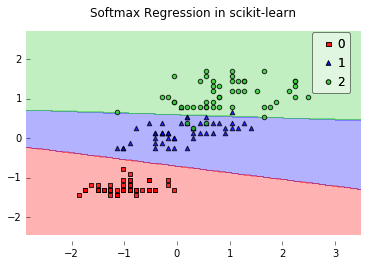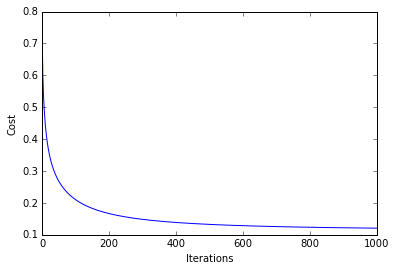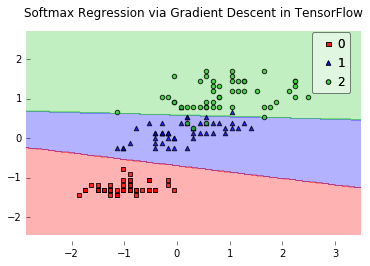Machine Learning FAQ
What is the main difference between TensorFlow and scikit-learn?
TensorFlow is more of a low-level library; basically, we can think of TensorFlow as the Lego bricks (similar to NumPy and SciPy) that we can use to implement machine learning algorithms whereas scikit-learn comes with off-the-shelf algorithms, e.g., algorithms for classification such as SVMs, Random Forests, Logistic Regression, and many, many more. TensorFlow really shines if we want to implement deep learning algorithms, since it allows us to take advantage of GPUs for more efficient training. To get a better idea of how these two libraries differ, let’s fit a softmax regression model on the Iris dataset via scikit-learn:
from sklearn.datasets import load_iris
from sklearn.linear_model import LogisticRegression
import matplotlib.pyplot as plt
# Loading Data
iris = load_iris()
X = iris.data[:, [0, 3]] # sepal length and petal width
y = iris.target
# standardize
X[:,0] = (X[:,0] - X[:,0].mean()) / X[:,0].std()
X[:,1] = (X[:,1] - X[:,1].mean()) / X[:,1].std()
lr = LogisticRegression(penalty='l2',
dual=False,
tol=0.000001,
C=10.0,
fit_intercept=True,
intercept_scaling=1,
class_weight=None,
random_state=1,
solver='newton-cg',
max_iter=100,
multi_class='multinomial',
verbose=0,
warm_start=False,
n_jobs=1)
lr.fit(X, y)
In addition, I have a little helper function to plot the 2D decision surface:
from mlxtend.plotting import plot_decision_regions
plot_decision_regions(X, y, clf=lr)
plt.title('Softmax Regression in scikit-learn')
plt.show()

That was easy, right? :). Now, if we want to fit a Softmax regression model via TensorFlow, however, we have to “build” the algorithm first. But it really sounds more complicated than it really is. TensorFlow comes with many “convenience” functions and utilities, for example, if we want to use a gradient descent optimization approach, the core or our implementation could look like this:
# Construct the Graph
g = tf.Graph()
with g.as_default():
if init_weights:
self._n_classes = np.max(y) + 1
self._n_features = X.shape[1]
tf_weights_, tf_biases_ = self._initialize_weights(
n_features=self._n_features,
n_classes=self._n_classes)
self.cost_ = []
else:
tf_weights_ = tf.Variable(self.weights_)
tf_biases_ = tf.Variable(self.biases_)
# Prepare the training data
y_enc = self._one_hot(y, self._n_classes)
n_idx = list(range(y.shape[0]))
tf_X = tf.convert_to_tensor(value=X, dtype=self.dtype)
tf_y = tf.convert_to_tensor(value=y_enc, dtype=self.dtype)
tf_idx = tf.placeholder(tf.int32,
shape=[int(y.shape[0] / n_batches)])
X_batch = tf.gather(params=tf_X, indices=tf_idx)
y_batch = tf.gather(params=tf_y, indices=tf_idx)
# Setup the graph for minimizing cross entropy cost
logits = tf.matmul(X_batch, tf_weights_) + tf_biases_
cross_entropy = tf.nn.softmax_cross_entropy_with_logits(logits,
y_batch)
cost = tf.reduce_mean(cross_entropy)
optimizer = tf.train.GradientDescentOptimizer(
learning_rate=self.eta)
train = optimizer.minimize(cost)
# Initializing the variables
init = tf.initialize_all_variables()
And we can execute the training as follows:
# Launch the graph
with tf.Session(graph=g) as sess:
sess.run(init)
self.init_time_ = time()
for epoch in range(self.epochs):
if self.minibatches > 1:
n_idx = np.random.permutation(n_idx)
minis = np.array_split(n_idx, self.minibatches)
costs = []
for idx in minis:
_, c = sess.run([train, cost], feed_dict={tf_idx: idx})
costs.append(c)
For demonstration purposes, I have implemented Softmax regression via TensorFlow in an object oriented style that is somewhat similar to scikit-learn's implementation. The complete code example can be found here if you are interested: [mlxtend/tf_classifier/TfSoftmax](https://github.com/rasbt/mlxtend/blob/master/mlxtend/tf_classifier/tf_softmax.py).
from mlxtend.tf_classifier import TfSoftmaxRegression
lr = TfSoftmaxRegression(eta=0.75,
epochs=1000,
print_progress=True,
minibatches=1,
random_seed=1)
lr.fit(X, y)
Epoch: 1000/1000 | Cost 0.12
plt.plot(range(len(lr.cost_)), lr.cost_)
plt.xlabel('Iterations')
plt.ylabel('Cost')
plt.show()

from mlxtend.evaluate import plot_decision_regions
plot_decision_regions(X, y, clf=lr)
plt.title('Softmax Regression via Gradient Descent in TensorFlow')
plt.show()

If you like this content and you are looking for similar, more polished Q & A’s, check out my new book Machine Learning Q and AI.